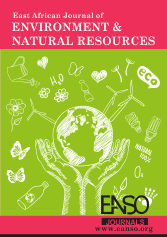The Impact of Urbanisation on Land use and Land Cover Change in Rwanda: A case of Muyumbu sector, Rwamagana District (2002-2024)
Résumé
Urbanisation in Rwanda, particularly in satellite cities such as Rwamagana District and especially in sectors bordering Kigali city like Muyumbu sector, has experienced rapid and uncontrolled growth, leading to significant changes in habitat and negatively impacting land use and land cover. Remote sensing data were used to thoroughly assess the impact of urbanisation on land use and land cover changes in the Muyumbu sector, Rwamagana District, from 2002 to 2024. Landsat images were obtained, pre-processed, and their accuracy verified before being used to analyse LCLU trends. The results for the first objective showed that Muyumbu has experienced significant urban growth between 2002 and 2024, with an annual growth rate of 5.07% due to population growth and population shift from rural areas to urban areas. The findings for the second objective revealed that the availability of land for development in Muyumbu surged, heightened demand for housing and services, and accelerated urbanisation in the study area. The results for the third and fourth objectives illustrated that from 2002 to 2024, urban areas grew from 32.85 Ha in 2002 to 646.40 Ha in 2024, reflecting a 12.18% overall increase. In contrast, agricultural land saw a sharp decline of 19.27%, primarily due to the significant expansion of urban areas. Forested areas (natural vegetation) experienced an approximate reduction of 9.15%, mainly driven by population growth. This population increase, combined with the migration of people from Kigali city to Muyumbu sector, was the primary factor contributing to urban growth. The findings also highlighted a clear link between urbanisation and changes in land use and land cover in the Muyumbu sector. Based on the findings of this study, there is a strong need for increased government support for the introduction and development of inspection technology like the use of drones and satellites, to prevent illegal construction activities and unauthorised deforestation, and enforce laws and related sanctions to whoever doing contrary to the zoning regulations. Relocate people from agricultural land to public apartments. To stop shifting people from so-called high-risk zones and start design and implement climate-resilient buildings. Adaptation of a robust monitoring system that tracks land use changes, deforestation rates to preserve green spaces. Additionally, the study suggests the need for supplementary policy measures to promote environmentally responsible development.
##plugins.generic.usageStats.downloads##
Références
Altman, M. (2023). How Biodiversity Loss Harms Human Health. New York: United Nations Foundation.
Demena, M. (2005). Population and Development. Ethiopia.
Celestin, M. (2022). Analysis of effective communication and project success: survey on electricity access rollout project at EDCL-EARP. Kigali, Rwanda: University of Rwanda.
Clark Nicholas & Cary Wu. (2021). Modernisation Theory. Switzerland: Springer Nature Switzerland AG.
Economist, T. (2012). "Urban life: Open-air computers".
FAO/UNDP. (1996). Our Land, Our Future. Rome: United Nations Environmental Programme.
Glaeser, E. L. (1999). Learning in cities. Journal of Urban Economics, 46 (2), 254-277
Group, C. C. (2023). Building for Progress: Why Infrastructure Development Is Worth the Trouble pp1. Florida: CIC.
Goorha, P. (2010). Modernization Theory.
Hensel, S. (2021). Data-Driven Research on Ecological Prototypes for Green Architecture: Enabling Urban Intensification and Restoration through Agricultural Hybrids. Vienna: Vienna University of Technology and Technical University of Munich.
Langemeyer. (2015). Urban Ecosystem Services: The Value of Green Spaces in Cities. Cities themselves present both the problems and solutions to sustainability challenges of an increasingly urbanized world. Stockholm University.
Li, C., Yang, M., & Li, Z. (2021). How Will Rwandan Land Use/Land Cover Change under High. China.
Lukas Egarter Vigl, D. D. (2022). Conceptualizing Human–Nature Interactions – An Overview. Italy.
Munyaneza Jean Pierre, R. P. (2023). The Impact of Urbanization Expansion on Agriculture Land in Rwanda: Case Study of Runda Sector, Kamonyi District. American Journal of Environmental Protection, 1-2.
Mukherjee, D. S. (2022). Central Place Theory - Christaller And Losch. Ranchi.
NISR. (2022). Fifth Population and Housing Census. Kigali, Rwanda: Ministry of Finance and Economic Planning.
Sanyaolo, P. (2018). Urbanisation. Nigeria.
Segarra, Buchaillot & Araus. (2020). Remote Sensing for Precision Agriculture: Sentinel-2 Improved Features and Applications. Barcelona: Agronomy.
Stephan Klasen, D. L. (2007). The Impact of Population Growth on. German.
Theoneste Bimenyimana, E. D. (2021). Impact of Urbanization on Land use and Land Cover Changes in Growing Cities of Rwanda. Journal of Korean Society of Environmental Engineers, pp2.
Thomas Weith, T. B. (2021). Sustainable land management in Europe- Human Environmental Interactions 8. Europe: Springer.
Turner and Meyer. (1994). Global land-use and land-cover change. Cambridge: Cambridge University Press.
Zimmerer. (2021). Urbanization and agrobiodiversity: Leveraging a key nexus for sustainable development. Department of Geography and Programs in Ecology and Rural Sociology, Pennsylvania State University, University Park, PA, USA.
Copyright (c) 2025 Emmanuel Hagumimana, Martin Vincent Nsanzumukiza

Ce travail est disponible sous la licence Creative Commons Attribution 4.0 International .




























